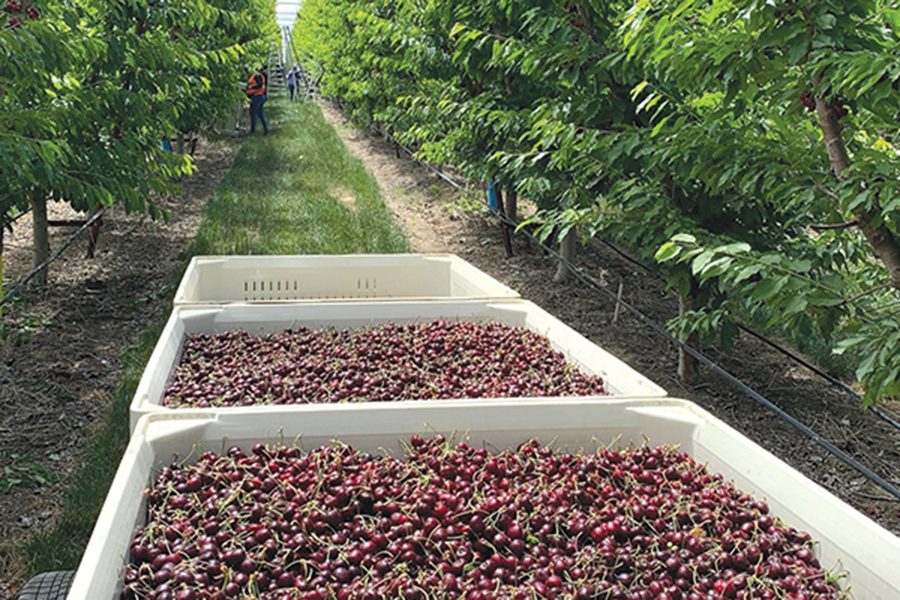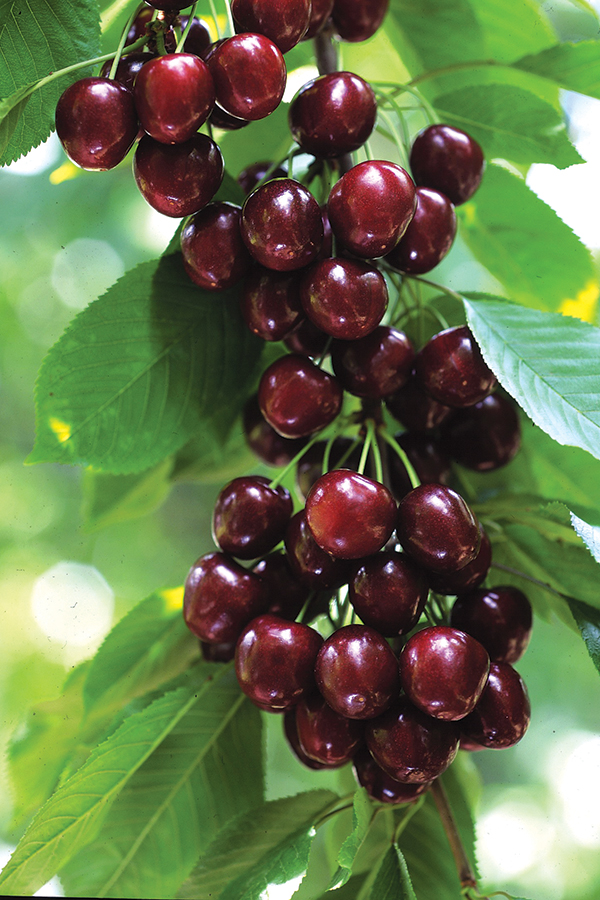
Home » Northwest cherries bounce back after difficult year
Sweeter season
Northwest cherries bounce back after difficult year

June 14, 2024
The 2024 cherry outlook appears rosier compared to the previous year’s challenging season.
The Pacific Northwest, comprised of Washington, Oregon, Idaho, Montana and Utah, is projected to produce 17 million to 18 million boxes of cherries in 2024. The 2023 crop was 18.7 million boxes, up 41% from 2022’s crop of 13.3 million boxes.
While state numbers hadn’t been released as of mid-May, Washington’s production is typically about 80% of that total.
In terms of size, this year’s crop isn’t very far off from last year’s. But for cherries, weather can make all the difference.
Challenges in 2023
Last year’s warm spring caused all of the state’s cherries to ripen at once.
“Though the total number of boxes was similar, the amount of time available to sell that fresh crop was substantially lower last year,” said Jon DeVaney, president of the Washington State Tree Fruit Association. “It was really financially challenging for growers.”
Typically, producers along the West Coast grow crops in various regions, altitudes and microclimates, which allows the cherries to mature in a sequence for a steady supply of fruit throughout the season.
When the Northwest’s cherries ripened earlier than usual in 2023, it created an overlap with California’s cherry crop.
“When you have overlap with another state’s production, it shortens the season, and so you’re trying to sell the same amount of product in a much more abbreviated period of time,” DeVaney said.
That’s because unlike apples or pears, cherries can’t be stored; instead, they go to market immediately after harvest.
“Would you like to eat 5 pounds of cherries over a week or in one day?” DeVaney asked.
Although the cherries were good quality, the shortened market period made the season financially difficult for growers. Ultimately, 2023’s season was declared a “weather-related disaster” by the U.S. Department of Agriculture.
Thanks to a more normal temperature development this year, 2024’s cherry crop is expected to thrive.
As of mid-May, the cherry harvest was set to begin around June 1 and likely will continue through August. Late June through July is the most abundant period for cherries.
 Courtesy Washington State Tree Fruit Association
Courtesy Washington State Tree Fruit AssociationInternational draw
About 30% of the Northwest’s cherries are exported, primarily to East Asia.
“We are still in an unsettled trade environment for some export markets,” said DeVaney, noting disputes between the U.S. and Chinese governments over trade policy.
Another issue at play in exports is the “appreciation of the value of the dollar relative to a lot of currencies in Asia,” DeVaney explained, “which makes our products more expensive overseas.”
Despite these challenges, demand for cherries remains strong, including in vital markets such as China, South Korea, Vietnam, Japan and Taiwan. Often, those consumers will pay a premium for Northwest cherries.
Overtime laws
The final phase of an overtime law passed in 2021 has set agricultural employees’ overtime threshold at 40 hours a week as of January.
The law has been enacted in phases since 2022, when agricultural employees transitioned from being exempt from overtime pay to receiving overtime after 55 hours per week, according to the Washington State Department of Labor & Industries.
The new 40-hour limit is a potential source of problems.
“Unlike a lot of office jobs where you can leave things in your inbox and come back to it on Monday, agricultural work is largely determined by weather conditions,” DeVaney said.
That means that labor can’t always be spread out consistently. Weather can slow or speed up a crop, so that one day a certain task might be impossible, while the next, everything needs to be done at once.
“Growers have to be prepared to respond to changing weather conditions so that they can pick their crop when it’s appropriate to be harvested,” DeVaney said.
In the cherry industry, the margin of profit can be very narrow. When producers have to pay time-and-a-half in overtime, they can end up doing the work at a loss.
“So if you are going to take a loss to do work, you’re just going to say, ‘Well, I won’t do that work, then.’ And that’s what we saw with low cherry prices last year,” DeVaney said.
Some orchards simply weren’t harvested. Instead, growers may stop the work when they hit the overtime threshold.
Although the mandatory overtime should increase workers’ wages, it can actually negatively impact workers, DeVaney said.
If producers stop harvesting once they reach 40 hours, the workers will never see that overtime pay, and they won’t have worked as many hours as they did previously.
“We continue to have discussions with legislators in Washington around the possibility of getting some flexibility for agriculture,” DeVaney said.
New and continuing impacts
A new federal regulation regarding H-2A workers is set to take effect on June 28 this year.
The federal program allows citizens of other countries to work in temporary agricultural jobs. The new regulation, called a final rule, will help protect H-2A workers, and applications under the new provisions will be accepted starting on Aug. 29.
The implications for local growers are unclear at this time.
Also new this legislative session is $30 million added to the state budget to assist producers with reimbursement for a previous error related to the Climate Commitment Act.
When the act went into effect in January 2023, agricultural operations should have been exempt from surcharges on fuel. However, many producers were charged anyway due to a lack of clarity.
The money set aside this legislative session will help producers to offset those charges.
Cherry growers also continue to face the challenges of little cherry disease.
It’s a virus that “can cause the trees to be less productive and have the cherries not grow to their full potential,” DeVaney said. He added that there is no cure other than removing the affected tree.
Growers must test and monitor their orchards to remove infected trees right away to avoid transmission to adjacent trees. According to DeVaney, the virus can be spread by certain leafhopper insects.
“It’s not something that consumers would directly experience, but it’s expensive for growers to have to replace their trees if they become infected,” DeVaney said.
Despite the industry’s challenges, this year’s harvest is expected to be a good one for cherries.
Favorable growing conditions mean high-quality cherries and good returns to the growers. After last year’s disaster, the forecast is optimistic.
“As the weather’s warming up, folks should be preparing themselves to enjoy some delicious summer cherries,” DeVaney said.
Focus Magazine Agriculture + Viticulture
KEYWORDS June 2024
Related Articles





